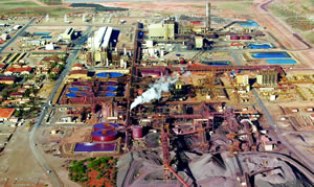In the course of identifying a 77% increase in mineral resources, BHP Billiton has defined a 27% increase in uranium resources, to 2.24 million tonnes of uranium oxide (1.9 million tU), at the Olympic Dam mine in South Australia. Known copper has increased 38% to 67 million tonnes and gold to 2450 tonnes.
 The new figures are based on 2095 km of drilling over the last two years, both from surface and underground, and confirm the deposit as the world's largest for uranium. It covers an area of over 6 km by 3.5 km, is up to 2 km deep and remains open laterally and at depth as the drilling program continues.
The new figures are based on 2095 km of drilling over the last two years, both from surface and underground, and confirm the deposit as the world's largest for uranium. It covers an area of over 6 km by 3.5 km, is up to 2 km deep and remains open laterally and at depth as the drilling program continues.
A preliminary feasibility study on tripling production is due for completion in 2008. If implemented, this would increase production to about 15,000 tonnes per year of uranium oxide (12,700 tU). Production in 2006-07 was 3474 tonnes U3O8 (2946 tU).
The resources are in three categories: measured resources of 472,000 tonnes, indicated resources of 907,000 tonnes and inferred resources of 857,000 tonnes - all JORC-compliant. These occur in a hematite-breccia complex at 250-350 metres depth.
Part of the pre-feasibility study involves looking at the option of exporting copper concentrate rather than refined copper, and hence some uranium contained in it. Because the Olympic Dam ore contains copper, uranium, silver and gold in close association, the common procedure of simply selling a copper concentrate with precious metals has not been viable, since some of the uranium would be in it, creating both processing and safeguards complications for the smelter operator. Most of the uranium is removed at the flotation stage when the copper sulphide is separated from the remainder of the ore, which is then tailings and the main uranium recovery is from acid leaching of these tailings. Secondary uranium recovery is from acid leaching the copper concentrate, which then goes on to be smelted, containing about 45% copper and 0.01% to 0.15% uranium. At present smelting is done at Olympic Dam, followed by electro refining, and the further traces of uranium are recovered at these stages.
A new possibility being considered would export the copper concentrate with enough uranium still present to require the application of safeguards, so that it was all accounted for. Hence smelting could only be undertaken in one of 36 countries with which Australia has a bilateral safeguards agreement, plus the heavy industry infrastructure required. China has been mentioned, but Japan and South Korea might also be candidates.
If all the copper from the expanded Olympic Dam operation were exported as concentrate, an average of 1.2 million tonnes per year would be involved, containing up to 2000 tonnes of uranium. The major part of the uranium - about 13,000 tonnes per year - would be recovered and processed as at present. The alternative strategy for the expanded production from Olympic Dam would greatly diminish the investment cost of the expansion since smelting and refining for the copper increment would not be required. The infrastructure needed to operate it - notably electricity - would also be less.
Further information
WNA's Australia's Uranium and Who Buys It information paper
UIC's Australia's Uranium Mines paper




_91467.jpg)
_47120.jpg)
_16439.jpg)






